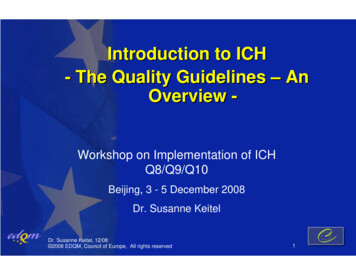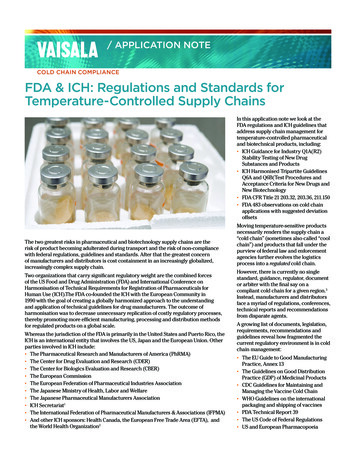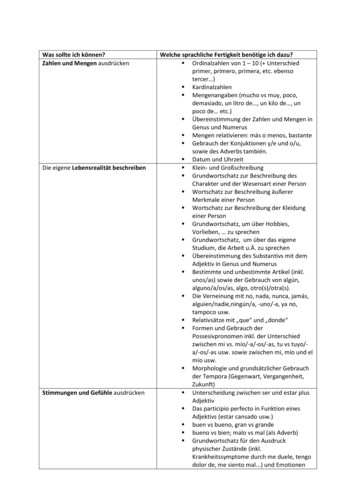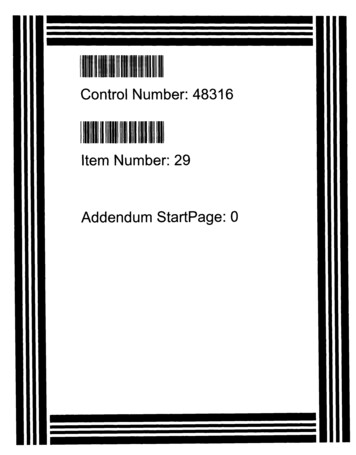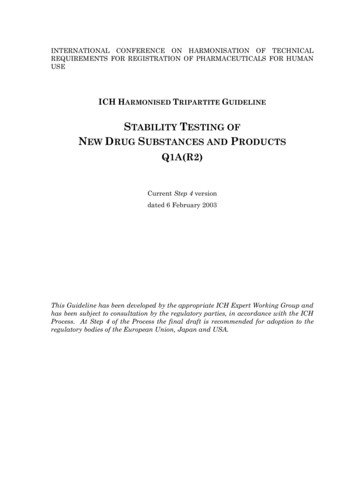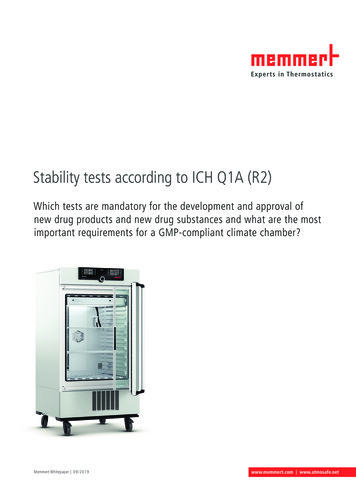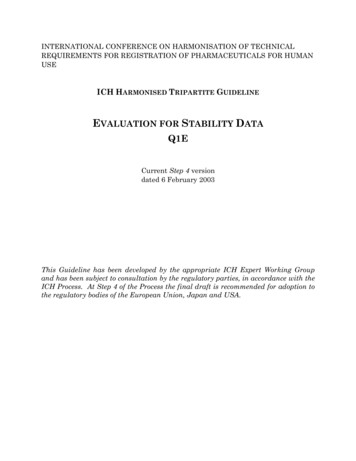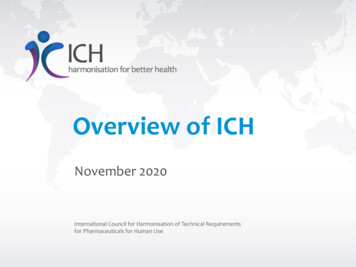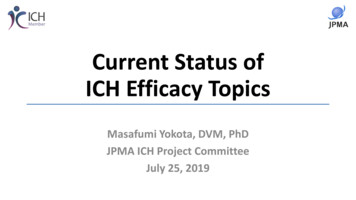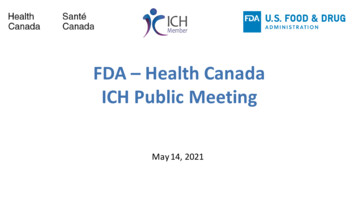
Transcription
ICH, WHO AND SUPACGUIDELINESICH GUIDELINESINTRODUCTION:The International Conference on Harmonisation of Technical Requirements forRegistration of Pharmaceuticals for Human Use (ICH) is a unique project that bringstogether the regulatory authorities of Europe, Japan and the United States andexperts from the pharmaceutical industry in the three regions to discuss scientificand technical aspects of product registration.The purpose is to make recommendations on ways to achieve greater harmonisationin the interpretation and application of technical guidelines and requirements forproduct registration in order to reduce or obviate the need to duplicate the testingcarried out during the research and development of new medicines.The objective of such harmonisation is a more economical use of human, animal andmaterial resources, and the elimination of unnecessary delay in the globaldevelopment and availability of new medicines whilst maintaining safeguards onquality, safety and efficacy, and regulatory obligations to protect public health.A BRIEF HISTORY OF ICH:Prior to 1960s there were not many controls over introduction of new drugs and alsoover the assurance of the quality by the manufacturer over his established drugproducts. Some stray tragic incidents in some countries like USA and India triggeredthe introduction of exacting drug laws to ensure the quality, safety and efficacy of thedrug.Around 1970s the pharmaceutical industry started getting global but the registrationof medicines remained a national responsibility. Although the laws of all the countrieswere based on the same fundamental obligations to evaluate the quality, safety andefficacy the detailed technical requirements differed from country to country. So thecompanies had to duplicate many time consuming and expensive test procedures, inorder to market new products, internationally. All this resulted in unnecessaryexpenses and long delays in introducing new drugs.So a necessity to harmonize or make uniform, the testing procedures and regulatoryrequirements of different countries was felt and the result is the birth of ICH in April1990.
Initiation of ICHThe birth of ICH took place at a meeting in April 1990, hosted by the EFPIA inBrussels. Representatives of the regulatory agencies and industry associations ofEurope, Japan and the USA met, primarily, to plan an International Conference butthe meeting also discussed the wider implications and terms of reference of ICH.The ICH Steering Committee which was established at that meeting has since met atleast twice a year, with the location rotating between the three regions.F o r m a t o f Ap p l i c a t i o n sA target for the first phase of ICH activities was to remove redundancy andduplication in the development and review process, such that a single set of datacould be generated to demonstrate the quality, safety and efficacy of a newmedicinal product. The long-term goal of developing a harmonised format has led tothe creation of the ICH Guideline M4, The Common Technical Document (CTD).The CTD provides a harmonised format and content for new product applications.The Electronic Common Technical Document (eCTD) was developedsubsequently by the M2 Expert Working Group. This specification document allowsfor the electronic submission of the CTD from applicant to regulator and provides aharmonised technical solution to implementing the CTD electronically. The eCTDhas begun to be implemented across the ICH partner and observerregionsGuidelinesObjectives of ICH: More economical use of human, animal, and material resources.Elimination of unnecessary delay in the global development & availability of newmedicines.Maintaining safeguards on Quality, safety & efficacy, and regulatory obligationsto protect public health.TOPICS OF ICH:Four Broad Categories - QSEM Quality (Q): those relating to chemical and pharmaceutical Quality Assurance(Stability Testing, Impurity Testing, etc.) Safety (S): those relating to in vitro and in vivo pre-clinical studies(Carcinogenicity Testing, Genotoxicity Testing, etc.) Efficacy (E): those relating to clinical studies in human subject (Dose ResponseStudies, Good Clinical Practices, etc.) Multidisciplinary (M): cross-cutting Topics which do not fit uniquely into one ofthe above categories (MedDRA, ESTRI, M3, CTD, M5)
Regulatory Public Consultation of ICH GuidelinesStep 2 of the ICH process is reached when the ICH Steering Committee agrees,based on the report of the EWG, that there is sufficient consensus on the technicalissues for the draft guideline or recommendation to proceed to the next stage ofregulatory consultation. The consensus text approved by the Steering Committee issigned off by the Steering Committee as the Step 2 Final Document.Under Step 3 of the ICH process, the Step 2 Guideline is subjected to regulatoryconsultation in the 3 ICH regions according to national/regional procedures.Comments received from regulatory consultation are considered by the EWG forincorporation into the final Step 4 Harmonised Tripartite Guideline which will be forregulatory implementation (Step 5) in the 3 ICH regionsPlease find below a list of the Step 2 ICH Guidelines currently undergoing regulatoryconsultation in the 3 ICH regions:C a t e g o r i e s o f I C H H a r m o n i s a t i o n Ac t i v i t i e sThe ICH harmonisation activities fall into 4 categories (see Table below). The originalFormal ICH Procedures involved a step-wise progression of guidelines. This processhas evolved to include maintenance activities (Maintenance Procedure), as anessential part of the ICH procedure.In addition to the maintenance activity, it is also important to have procedures inplace to enable the modification of existing guidelines (Revision Procedure), as wellas to assist in their implementation (Q&A Procedure).Category1Type ofprocedureFormal mpleEWGDevelopment of anew guidelineM5 (DataElements andStandards forDrug DictionariesCTD-IWGE2B(R3)2Q&A procedureIWGCreation of Q&As toassist theimplementation ofexisting onof existing guidelinesEWGAdding Standards toQ3C(R3)existing aintenanceprocedure
Structure of ICHICH is a joint initiative involving both regulators and industry as equal partners in thescientific and technical discussions of the testing procedures which are required toensure and assess the safety, quality and efficacy of medicines.The focus of ICH has been on the technical requirements for medicinal productscontaining new drugs. The vast majority of those new drugs and medicines aredeveloped in Western Europe, Japan and the United States of America andtherefore, when ICH was established, it was agreed that its scope would be confinedto registration in those three regions.ICH is comprised of Six Parties that are directly involved, as well as three Observersand IFPMA. The Six Parties are the founder members of ICH which represent theregulatory bodies and the research-based industry in the European Union, Japanand the USA. These parties include the EU, EFPIA, MHLW, JPMA, FDA andPhRMA.The Observers are WHO, EFTA, and Canada (represented by Health Canada). Thisimportant group of non-voting members acts as a link between the ICH and non-ICHcountries and regions.ICH is operated via the ICH Steering Committee, which is supported by ICHCoordinators and the ICH Secretariat.ICH PARTIES:European Commission - European Union (EU)European Federation of Pharmaceutical Industries and Associations (EFPIA)Ministry of Health, Labour and Welfare, Japan (MHLW)Japan Pharmaceutical Manufacturers Association (JPMA)US Food and Drug Administration (FDA)Pharmaceutical Research and Manufacturers of America (PhRMA)ICH Steering CommitteeICH is administered by the ICH Steering Committee which is supported by the ICHSecretariat. The ICH Steering Committee (SC) was established in April 1990, whenICH was initiated. The Steering Committee, working with the ICH Terms ofReference, determines the policies and procedures for ICH, selects topics forharmonisation and monitors the progress of harmonisation initiatives. The SteeringCommittee meets at least twice a year with the location rotating between the threeregions.Since the beginning, each of the six co-sponsors has had two seats on the ICHSteering Committee (SC) which oversees the harmonisation activities. IFPMAprovides the Secretariat and participates as a non-voting member of the SteeringCommittee.
The ICH Observers, WHO, Health Canada, and the European Free TradeAssociation (EFTA) nominate non-voting participants to attend the ICH SteeringCommittee Meetings.OVERVIEW OF ICH GUIDELINE:1) Q5BQ5CQ5DQ6AQ7AQ8Q9Q10STABILITY TESTING IN NEW DRUGS AND PRODUCTS(REVISEDGUIDELINE)PHOTOSTABILITY TESTINGSTABILITY TESTING:NEW DOSAGE FORMSBRACKETING AND MATRIXING DESIGNS FOR STABILITY TESTINGOF DRUG SUBSTANCES AND DRUG PRODUCTSEVALUATION OF STABILITY DATASTABILITY DATA PACKAGE FOR REGISTRATION IN CLIMATICZONES III AND IVDEFINTIONS AND TERMINOLOGY:ANALUTICAL VALIDATIONMETHODOLOGYIMPURITY TESTING IN NEW DRUG SUBSTANCESIMPURITIES IN DOSAGE FORMS: ADDENDUN TO THE GUIDELINEON IMPURITIES IN NEW DRUG SUBSTANCESIMPURITIES:RESIDUAL SOLVENTSPHARMACOPOEIAL HARMONIZATIONVIRAL SAFETY EVALUATIONGENETIC STABILITYSTABILITY OF BIOTECHNOLOGY PRODUCTSCELL SUBSTRATESSPECIFICATIONS, TEST PROCEDURES, AND ACCEPTANCECRITERIA FOR NEW DRUG SUBSTANCES AND PRODUCTSGMP FOR ACTIVE PHARMACEUTICAL INGREDIENTSPHARMACEUTICAL DEVELOPMENTQUALITY RISK MANAGEMENTPHARMACEUTICAL QUALITY SYSTEM2) SAFETY:S1AS1BS1C(R2)S2(R1)S3AS3BS4GUIDELINE ON THE NEED FOR CARCINOGENICITY STUDIES OFPHARMACEUTICALSTESTING FOR CARCINOGENICITY OF PHARMACEUTICALSDOSE SELECTION FOR CARCINOGENICITY STUDIES OF PHARMACEUTICALSGUIDANCE ON GENOTOXICITY TESTING AND DATA INTERPRETATION FORPHARMACEUTICALS INTENDED FOR HUMAN USENOTE FOR GUIDANCE ON TOXICOKINETICS: THE ASSESSMENT OF SYSTEMICEXPOSURE IN TOXICITY STUDIESPHARMACOKINETICS:GUIDANCE FOR REPEATED DOSE TISSUE DISTRIBUTIONSTUDIESDURATION OF CHRONIC TOXICITY TESTING IN ANIMALS(RODENT AND NON RODENT TOXICITY TESTING)
S5(R2)S6(R1)S6S7AS7BS8S9DETECTION OF TOXICITY TO REPRODUCTIONFOR MEDICINAL PRODUCTS & TOXICITY TO MALE FERTILITYADDENDUM TO ICH S6: PRECLINICAL SAFETY EVALUATION OFBIOTECHNOLOGY-DERIVED PHARMACEUTICALSPRECLINICAL SAFETY EVALUATION OF BIOTECHNOLOGY-DERIVEDPHARMACEUTICALSSAFETY PHARMACOLOGY STUDIES FOR HUMAN PHARMACEUTICALSTHE NON-CLINICAL EVALUATION OF THE POTENTIAL FOR DELAYEDVENTRICULAR REPOLARIZATION (QT INTERVAL PROLONGATION) BY HUMANPHARMACEUTICALSIMMUNOTOXICITY STUDIES FOR HUMAN PHARMACEUTICALSNONCLINICAL EVALUATION FOR ANTICANCER PHARMACEUTICALS3) EFFICACY:E1E2AE2B(R2)E2B(R3)E2C(R1)E2DTHE EXTENT OF POPULATION EXPOSURE TO ASSESS CLINICAL SAFETYCLINICAL SAFETY DATA MANAGEMENTMAINTENANCE OF THE ICH GUIDELINE ON CLINICAL SAFETY DATAMANAGEMENTREVISION OF THE ICH GUIDELINE ON CLINICAL SAFETY DATA MANAGEMENTDATA ELEMENTS FOR TRANSMISSION OF INDIVIDUAL CASE SAFETY REPORTSCLINICAL SAFETY DATA MANAGEMENT: PERIODIC SAFETY UPDATE REPORTSFOR MARKETED DRUGSPOST-APPROVAL SAFETY DATA MANAGEMENT: DEFINITIONS ANDSTANDARDS FOR EXPEDITED REPORTINGE2EPHARMACOVIGILANCE PLANNINGE2FDEVELOPMENT SAFETY UPDATE REPORTE3E4STRUCTURE AND CONTENT OF CLINICAL STUDY REPORTSDOSE-RESPONSE INFORMATION TO SUPPORT DRUGREGISTRATIONETHNIC FACTORS IN THE ACCEPTABILITY OF FOREIGN CLINICAL DATAGUIDELINE FOR GOOD CLINICAL PRACTICESTUDIES IN SUPPORT OF SPECIAL POPULATIONS:GERIATRICSGENERAL CONSIDERATIONS FOR CLINICAL TRIALSSTATISTICAL PRINCIPLES FOR CLINICAL TRIALSCHOICE OF CONTROL GROUP AND RELATED ISSUES IN CLINICAL TRIALSCLINICAL INVESTIGATION OF MEDICINAL PRODUCTS IN THE PEDIATRICPOPULATIONPRINCIPLES FOR CLINICAL EVALUATION OF NEW ANTIHYPERTENSIVE DRUGSTHE CLINICAL EVALUATION OF QT/QTC INTERVAL PROLONGATION ANDPROARRHYTHMIC POTENTIAL FOR NON-ANTIARRHYTHMIC DRUGSE5(R1)E6(R1)E7E8E9E10E11E12E14E15DEFINITIONS FOR GENOMIC BIOMARKERS, PHARMACOGENOMICS,PHARMACOGENETICS, GENOMIC DATA AND SAMPLE CODING CATEGORIESE16GENOMIC BIOMARKERS RELATED TO DRUG RESPONSE:
CONTEXT, STRUCTURE AND FORMAT OF QUALIFICATION SUBMISSIONS4) MULTIDISCIPLINARY;M2 (R2)ELECTRONIC TRANSMISSION OF INDIVIDUAL CASE SAFETY REPORTSMESSAGE SPECIFICATIONM3(R2)GUIDANCE ON NONCLINICAL SAFETY STUDIES FOR THE CONDUCT OFHUMAN CLINICAL TRIALS AND MARKETING AUTHORIZATION FORPHARMACEUTICALSORGANISATION OF THE COMMON TECHNICAL DOCUMENT FOR THEREGISTRATION OF PHARMACEUTICALS FOR HUMAN USETHE COMMON TECHNICAL DOCUMENT FOR THEREGISTRATION OF PHARMACEUTICALS FOR HUMAN USE:EFFICACYTHE COMMON TECHNICAL DOCUMENT FOR THEREGISTRATION OF PHARMACEUTICALS FOR HUMAN USE:QUALITYTHE COMMON TECHNICAL DOCUMENT FOR THEREGISTRATION OF PHARMACEUTICALS FOR HUMAN USE:SAFETYM4M4E(R1)M4Q(R1)M4S(R2)M5DATA ELEMENTS AND STANDARDS FOR DRUG DICTIONARIESSafety, Efficacy and Multidisciplinary are not covered here.as we are muchconcerned with Quality Guidelines.In Quality Guidelines Q1A,Q1B,Q1C,Q1D and Q3 Topics are already covered inStability Studies(SEM-I)Q1E: EVALUATION OF THE STABILITY DATA1. INTRODUCTION1.1 OBJECTIVES OF THE GUIDELINE This guideline is intended to provide recommendations on how to use stability datagenerated in accordance with the principles detailed in the ICH guideline ―Q1A(R)Stability Testing of New Drug Substances and Products‖ (here after referred as theparent guideline) to propose a retest period/shelf life in a registration application. This guideline describes when and how extrapolation can be considered when proposinga retest period for a drug substance or a shelf life for a drug product that extends beyondthe period covered by ―available data from the stability study under the long-term storagecondition‖ (hereafter referred to as long-term data).1.2 BACKGROUND The guidance on the evaluation and statistical analysis of stability data provided in theparent guideline is brief in nature and limited in scope. The parent guideline states that regression analysis is an appropriate approach toanalyzing quantitative stability data for retest period or shelf life estimation andrecommends that a statistical test for batch poolability be performed using a level ofsignificance of 0.25.
However, the parent guideline includes few details and does not cover situations wheremultiple factors are involved in a full- or reduced-design study.1.3 SCOPE OF THE GUIDELINE This guideline addresses the evaluation of stability data that should be submitted inregistration applications for new molecular entities and associated drug products.2. GUIDELINES2.1 GENERAL PRINCIPLES The design and execution of formal stability studies should follow the principles outlinedin the parent guideline.A systematic approach should be adopted to the presentation and evaluation of stabilityinformation, which should include, as necessary, physical, chemical, biological andmicrobiological test characteristics.All product characteristics likely to be affected by storage, e.g. assay value or potency,content of products of decomposition, physicochemical properties (hardness,disintegration, particulate matter, etc.), should be determined; for solid or semi-solid oraldosage forms, dissolution tests should be carried out.Test methods to demonstrate the efficacy of additives, such as antimicrobial agents,should be used to determine whether such additives remain effective and unchangedthroughout the projected shelf-life.Analytical methods should be validated or verified, and the accuracy as well as theprecision (standard deviations) should be recorded. The assay methods chosen shouldbe those indicative of stability.The tests for related compounds or products of decomposition should be validated todemonstrate that they are specific to the product being examined and are of adequatesensitivity.2.2 DATA PRESENTATION Data for all attributes should be presented in an appropriate format (e.g., tabular,graphical, narrative) and an evaluation of such data should be included in theapplication.A checklist similar to that used in the WHO survey on the stability of pharmaceuticalpreparations included in the WHO Model List of Essential Drugs (Appendix 1) can beused to determine the other stability characteristics of the product.1. Tabulate and plot stability data on all attributes at all storage conditions and evaluateeach attribute separately.2. No significant change at accelerated conditions within six (6) months.3. Long-term data show little or no variability and little or no change over time.STABILITY PROTOCOL AND REPORT1.2.3.4.Batches testedGeneral informationContainer/closure systemLiterature and supporting data
5. Stability-indicating analytical methods6. Testing plan7. Test parameters8. Test results9. Other requirements (post-approval commitments)10. ConclusionsResult sheets must bear date and responsible person signature / QA approvalThe batches should be representative of the manufacturing process and should bemanufactured from different batches of key intermediates.ILLUSTRATIVE DATA OF CAPSULE/TABLET STABILITY BATCHESBatch numberDate of manufactureSite of manufactureBatch size (kg)20100100Batch size (number of units)Primary packing materialsDate of initial analysisBatch number of the API2.3 EXTRAPOLATION Extrapolation is the practice of using a known data set to infer information about futuredata.Extrapolation to extend the retest period or shelf life beyond the period covered by longterm data can be proposed in the application, particularly if no significant change isobserved at the accelerated condition.2.4 DATA EVALUATION FOR RETEST PERIOD OR SHELF LIFE ESTIMATION FORDRUG SUBSTANCES OR PRODUCTS INTENDED FOR ROOM TEMPERATURESTORAGE2.4.1 No significant change at accelerated condition Where no significant change occurs at the accelerated condition, the retest period orshelf life would depend on the nature of the long-term and accelerated data.
2.4.2 Significant change at accelerated condition Where significant change* occurs at the accelerated condition, the retest period or shelflife would depend on the outcome of stability testing at the intermediate condition, as wellas at the long-term condition.*Note: The following physical changes can be expected to occur at the accelerated conditionand would not be considered significant change that calls for intermediate testing if there isno other significant change: Softening of a suppository that is designed to melt at 37ºC, if the melting point is clearlydemonstrated,Failure to meet acceptance criteria for dissolution for 12 units of a gelatin capsule or gelcoated tablet if the failure can be unequivocally attributed to cross-linking.
However, if phase separation of a semi-solid dosage form occurs at the acceleratedcondition, testing at the intermediate condition should be performed. Potential interactioneffects should also be considered in establishing that there is no other significant change.2.4.2 Significant change at accelerated condition2.4.2.1 No significant change atconditionThe extent of extrapolation would depend onwhether long-term data for the attribute areamenable to statistical analysis.Data not amenable tostatistical analysis2.4.2.2 Significant change at intermediateintermediate conditionThe proposed retest period orshelf life should not exceed the periodcovered by long-term dataData amenable tostatistical analysisThe proposed retest periodThe proposed retest period or shelf life can beor shelf life can be up toup to one-and-half times, but should not be3 months beyond the period more than 6 months beyond, the period coveredcovered by long-term databy long-term data2.5 DATA EVALUATION FOR RE-TEST PERIOD OR SHELF LIFE ESTIMATION FORDRUG SUBSTANCES OR PRODUCT INTENDED FOR STORAGE BELOW ROOMTEMPERATURE2.5.1 Drug substances or products intended for storage in a refrigerator2.5.2 Drug substances or products intended for storage in a
The ICH Observers, WHO, Health Canada, and the European Free Trade Association (EFTA) nominate non-voting participants to attend the ICH Steering Committee Meetings. OVERVIEW OF ICH GUIDELINE: 1) QUALITY: Q1A(R2) STABILITY TESTING IN NEW DRUGS AND PRODUCTS(REVISED GUIDELINE) Q1B PHOT
